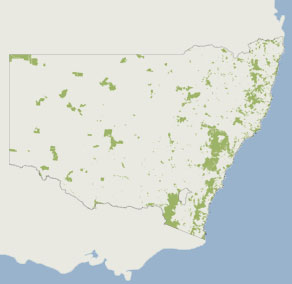Wollondilly River walking track
Guula Ngurra National Park
Visitor info
All the practical information you need to know about Wollondilly River walking track.
Track grading
Features of this track
Distance
8km return
Time
4 - 6hrs
Quality of markings
Limited signage
Experience required
Very experienced bushwalkers
Gradient
Very steep and difficult
Steps
Occasional steps
Quality of path
Rough track, many obstacles
Getting there and parking
Wollondilly River walking track is in the Little Forest West area of Guula Ngurra National Park. To get there from Sydney or Goulburn:
- Follow the M31 and take the Illawarra Highway – Moss Vale exit, following signs to Canyonleigh.
- Continue for 10km on Canyonleigh Road, then turn right onto Tugalong Road.
- Travel 20km along Tugalong Road and then turn left at the small Guula Ngurra National Park entry sign onto the Dirrang Management Trail.
- Open the entry gate, drive 100m along the trail and then park in the clear, open area on your right.
- There is a locked gate after the carpark with pedestrian access to the Wollondilly River walking track.
Road quality
- Mixture of sealed and unsealed roads
Vehicle access
- 2WD vehicles
Weather restrictions
- All weather
Parking
An informal parking area for 5 cars is available on the Dirrang Management Trail within the Little Forest West area, just before the trail head. A formal parking area for 5 cars is available in the Mount Penang area 2.5km north, along Tugalong Road.
Best times to visit
Autumn
Autumn's a great time to visit as you escape the heat of summer and avoid the chill of winter.
Spring
If you're interested in wildflowers, visit in spring to see them in bloom throughout the park.
Facilities
There are no bins so you'll need to take all rubbish away with you.
Carpark
Informal parking is available at Wollondilly River walking track.
Maps and downloads
Accessibility
Disability access level - no wheelchair access
Prohibited
Hunting and shooting native animals or poaching wildlife is prohibited. Report illegal activities.
Camp fires and solid fuel burners
Cycling
Generators
Pets
Pets and domestic animals (other than certified assistance animals) are not permitted. Find out which regional parks allow dog walking and see the pets in parks policy for more information.
Smoking
NSW national parks are no smoking areas.

Operated by
- Mount Annan office
- 02 4632 4500
- npws.hawkesburynattai@environment.nsw.gov.au
Park info
- in Guula Ngurra National Park in the Country NSW region
Guula Ngurra National Park is open to the public but may be closed at short notice due to special operations, poor weather or fire danger.
Public vehicles are not permitted inside the park without consent to protect sensitive natural and cultural heritage values. Visitors to the Tugalong area must park outside the main gate.
